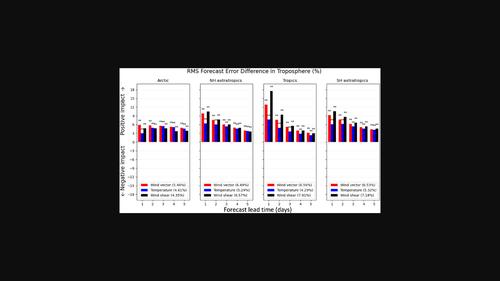风风对全球预报系统的尺度依赖影响
IF 3
3区 地球科学
Q2 METEOROLOGY & ATMOSPHERIC SCIENCES
引用次数: 0
摘要
欧洲航天局的Aeolus任务于2018年8月发射,首次提供了全球水平视线风廓线测量。以前的研究表明,全球预报系统中的风提高了整体预报技能,特别是在对流层上层热带地区和其他数据稀疏地区。在这项研究中,我们利用最新版本的Aeolus再加工风产品(2B11)进行了一系列观测系统实验,以更好地表征Aeolus技术改进的位置和驱动因素,以及加拿大环境与气候变化全球确定性预测系统。在2019年夏季和2019 - 2020年冬季进行了观测系统试验,测试了风沙风的影响和所有业务风观测的影响。业务风的同化使热带对流层风预报误差降低了8%,在同化中加入风分风可使预报误差增加0.7-0.9%。风对北极的影响改善了0.7-0.9%,对北半球和南半球温带地区的影响改善了0.4-0.6%。利用空间谱(球谐分解)研究了这些影响的尺度依赖性。利用实验间250 hPa动能预报误差谱的差值来量化改进。在短期预报中,对于1 ~ 20之间的球形波数,操作风在很大程度上提高了行星尺度到中尺度的预报。随着预报提前期的增加,运行风的影响减小。另一方面,风的影响主要出现在中到大尺度范围内,峰值出现在球波数8附近。随着预报提前期的增加,与风相关的波数改善也在增加。这一分析表明,风量风提供了对风状态的估计,这是有价值的,是对当前业务风提供的估计的补充。本文章由计算机程序翻译,如有差异,请以英文原文为准。

Scale‐dependent impact of Aeolus winds on a global forecast system
Abstract The European Space Agency's Aeolus mission, launched in August 2018, provides the first global horizontal line‐of‐sight wind profile measurements. Previous studies have shown that Aeolus winds in global forecast systems improve the overall forecast skill, especially in the upper tropospheric tropics and in other data‐sparse regions. In this study, we use a series of observing system experiments with the latest version of the reprocessed Aeolus wind product (2B11) to better characterize the locations and drivers of improved skill from Aeolus with Environment and Climate Change Canada's Global Deterministic Prediction System. Observing system experiments that test the impact of Aeolus winds and the impact of all operational wind observations are carried out, covering the period summer 2019 and winter 2019–2020. Assimilation of operational winds improves the tropospheric wind forecast over the Tropics by a reduction of 8% in the forecast error, and adding the Aeolus winds to the assimilations results in an extra 0.7–0.9%. Aeolus wind impacts are improvements are 0.7–0.9% for the Arctic, and 0.4–0.6% over the Northern and Southern Hemisphere extratropics. The scale dependence of these impacts is investigated using spatial spectra (spherical harmonic decomposition). The improvement is quantified using the difference of the 250 hPa kinetic energy forecast error spectra between experiments. The operational winds largely improve the forecast of planetary scale to intermediate scale for spherical wave numbers between 1 and 20 in the short‐range forecasts. The operational wind impact decreases as the forecast lead time increases. On the other hand, the impact of Aeolus is mostly seen in the intermediate to large scale range with a peak around spherical wave number 8. The Aeolus ‐related improvement around this wave number increases with forecast lead time. This analysis suggests that Aeolus winds provide estimates of the wind state that are valuable and complementary to that provided from current operational winds.
求助全文
通过发布文献求助,成功后即可免费获取论文全文。
去求助
来源期刊
CiteScore
16.80
自引率
4.50%
发文量
163
审稿时长
3-8 weeks
期刊介绍:
The Quarterly Journal of the Royal Meteorological Society is a journal published by the Royal Meteorological Society. It aims to communicate and document new research in the atmospheric sciences and related fields. The journal is considered one of the leading publications in meteorology worldwide. It accepts articles, comprehensive review articles, and comments on published papers. It is published eight times a year, with additional special issues.
The Quarterly Journal has a wide readership of scientists in the atmospheric and related fields. It is indexed and abstracted in various databases, including Advanced Polymers Abstracts, Agricultural Engineering Abstracts, CAB Abstracts, CABDirect, COMPENDEX, CSA Civil Engineering Abstracts, Earthquake Engineering Abstracts, Engineered Materials Abstracts, Science Citation Index, SCOPUS, Web of Science, and more.

 求助内容:
求助内容: 应助结果提醒方式:
应助结果提醒方式:


